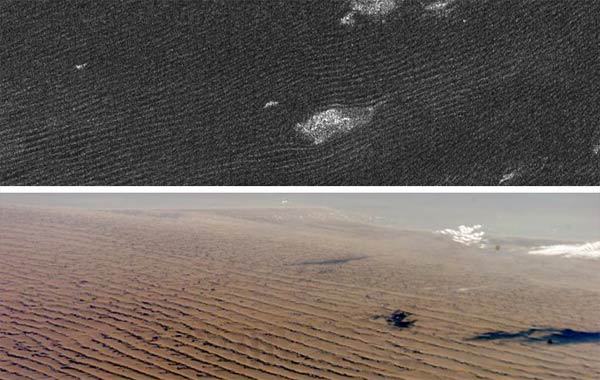The Riddle of the Dunes on Titan

Ten years ago, scientists were surprised to receive from Cassini strikingly beautiful photos from Titan, Saturn’s largest satellite. This is generally an amazing cosmic body. Unlike other satellites, it has a dense atmosphere. There are rivers and lakes of liquefied ethane and methane. But the most surprising is the dunes hundreds of meters high and tens of kilometers long.
Scientists still can not say from what bulk material dunes are made and what is its source. It is not clear how the dunes of this form are formed. This requires a fairly strong wind, but Cassini did not find such a thing. In addition, the shape of the dunes around obstacles such as mountains and craters shows that the dunes are formed by the westerly wind, but Cassini only showed a constant weak east wind on the satellite.

')
Researchers from the Department of Earth and Planetary Sciences at the University of Tennessee have tried to solve the mystery of the dunes on Titan. The results of their scientific work published yesterday in the journal Nature.
Scientists under the guidance of associate professor Devona Burr (Devon Burr) adapted for testing the old high-pressure wind tunnel NASA, which has long been out of order.

Six years (!) They spent on the restoration of the pipe and the recreation of atmospheric conditions on Titan.
Since the composition of the sand on the surface is unknown, the scientists tested 23 loose mixes of different consistency.
After two more years of modeling and reconfiguration of the installation, it turned out that the minimum wind force required to form such dunes should be 50% more than previously thought, in accordance with previous computer models designed for a more rarefied atmosphere.
In addition, it was found that the dunes are formed by short periods of strong westerly wind. According to atmospheric models, the constant weak east wind on Titan can be replaced by short-term gaps of the strong west wind. This happens once a year on Titan (one year corresponds to about 30 Earth years) when the Sun crosses the equator. Due to the rarity of the phenomenon, Cassini could have missed it (or the formation of the dunes was completed in the past, but now there are no such winds).
The formation of the dunes itself took about 3,000 local years (88,200 Earth years).
via phys.org
Source: https://habr.com/ru/post/364123/
All Articles